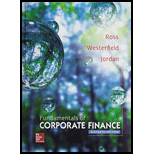
Fundamentals of Corporate Finance with Connect Access Card
11th Edition
ISBN: 9781259418952
Author: Stephen A. Ross Franco Modigliani Professor of Financial Economics Professor, Randolph W Westerfield Robert R. Dockson Deans Chair in Bus. Admin., Bradford D Jordan Professor
Publisher: McGraw-Hill Education
expand_more
expand_more
format_list_bulleted
Question
Chapter 5.2, Problem 5.2DCQ
Summary Introduction
To determine: The
Introduction:
Present value refers to the current worth of the future
Expert Solution & Answer
Want to see the full answer?
Check out a sample textbook solution
Students have asked these similar questions
A higher beta in a stock indicates:A. Lower volatilityB. Higher volatilityC. No riskD. Stable return
Need help!!
The time value of money concept is based on the idea that:A. Money loses value over timeB. Money today is worth more than the same amount in the futureC. Inflation doesn't impact moneyD. Currency values never change
The time value of money concept is based on the idea that:A. Money loses value over timeB. Money today is worth more than the same amount in the futureC. Inflation doesn't impact moneyD. Currency values never change
Chapter 5 Solutions
Fundamentals of Corporate Finance with Connect Access Card
Ch. 5.1 - Prob. 5.1ACQCh. 5.1 - Prob. 5.1BCQCh. 5.1 - Prob. 5.1CCQCh. 5.2 - Prob. 5.2ACQCh. 5.2 - Prob. 5.2BCQCh. 5.2 - What do we mean by discounted cash flow, or DCF,...Ch. 5.2 - Prob. 5.2DCQCh. 5.3 - Prob. 5.3ACQCh. 5.3 - Prob. 5.3BCQCh. 5 - You deposited 2,000 in a bank account that pays 5...
Ch. 5 - Prob. 5.2CTFCh. 5 - Charlie invested 6,200 in a stock last year....Ch. 5 - Prob. 1CRCTCh. 5 - Compounding [LO1, 2] What is compounding? What is...Ch. 5 - Prob. 3CRCTCh. 5 - Compounding and Interest Rates [LO1, 2] What...Ch. 5 - Prob. 5CRCTCh. 5 - Prob. 6CRCTCh. 5 - Prob. 7CRCTCh. 5 - Prob. 8CRCTCh. 5 - Prob. 9CRCTCh. 5 - Prob. 10CRCTCh. 5 - Prob. 1QPCh. 5 - Prob. 2QPCh. 5 - Calculating Present Values [LO2] For each of the...Ch. 5 - Calculating Interest Kates [LO3] Solve for the...Ch. 5 - Prob. 5QPCh. 5 - Calculating Interest Rates [LO3] Assume the total...Ch. 5 - Prob. 7QPCh. 5 - Calculating Interest Rates [LO3] According to the...Ch. 5 - Calculating the Number of Periods [LO4] Youre...Ch. 5 - Prob. 10QPCh. 5 - Prob. 11QPCh. 5 - Prob. 12QPCh. 5 - Calculating Interest Rates and Future Values [LO1,...Ch. 5 - Calculating Rates of Return [LO3] Although...Ch. 5 - Prob. 15QPCh. 5 - Prob. 16QPCh. 5 - Calculating Present Values [LO2] Suppose you are...Ch. 5 - Prob. 18QPCh. 5 - Calculating Future Values [LO1] You are scheduled...Ch. 5 - Prob. 20QP
Knowledge Booster
Similar questions
- Diversification in investing helps to:A. Eliminate all riskB. Increase potential lossesC. Reduce unsystematic riskD. Increase taxesarrow_forwardNo Ai!!! Diversification in investing helps to:A. Eliminate all riskB. Increase potential lossesC. Reduce unsystematic riskD. Increase taxesarrow_forwardI need help in this question! Diversification in investing helps to:A. Eliminate all riskB. Increase potential lossesC. Reduce unsystematic riskD. Increase taxesarrow_forward
- I need help in this question What is the primary goal of corporate finance?A. Minimizing taxesB. Maximizing employee satisfactionC. Maximizing shareholder valueD. Avoiding debtarrow_forwardWhat is the primary goal of corporate finance?A. Minimizing taxesB. Maximizing employee satisfactionC. Maximizing shareholder valueD. Avoiding debtarrow_forwardDon't use AI . A bond with a face value of $1,000 and a coupon rate of 5% pays how much interest annually?A. $10B. $50C. $500D. $5arrow_forward
- A bond with a face value of $1,000 and a coupon rate of 5% pays how much interest annually?A. $10B. $50C. $500D. $5arrow_forwardWhich of the following is NOT a typical characteristic of a bond? a) Fixed interest paymentsb) Principal repayment at maturityc) Ownership in the companyd) Issued by governments or corporationsarrow_forwardDon't use Ai. In the context of financial markets, what does liquidity refer to? a) The ability to generate profitsb) The ability to buy or sell an asset without affecting its price significantlyc) The ability to pay off liabilitiesd) The number of shares in circulationarrow_forward
- I need help!! In the context of financial markets, what does liquidity refer to? a) The ability to generate profitsb) The ability to buy or sell an asset without affecting its price significantlyc) The ability to pay off liabilitiesd) The number of shares in circulationarrow_forwardWhat is the main risk associated with investing in stocks? a) Credit riskb) Market riskc) Inflation riskd) Liquidity riskarrow_forwardWhich of the following is an example of a fixed income security? a) Stockb) Treasury Bondc) Mutual Fundd) Real Estate Investment Trust need help!arrow_forward
arrow_back_ios
SEE MORE QUESTIONS
arrow_forward_ios
Recommended textbooks for you
 EBK CONTEMPORARY FINANCIAL MANAGEMENTFinanceISBN:9781337514835Author:MOYERPublisher:CENGAGE LEARNING - CONSIGNMENTPrinciples of Accounting Volume 2AccountingISBN:9781947172609Author:OpenStaxPublisher:OpenStax College
EBK CONTEMPORARY FINANCIAL MANAGEMENTFinanceISBN:9781337514835Author:MOYERPublisher:CENGAGE LEARNING - CONSIGNMENTPrinciples of Accounting Volume 2AccountingISBN:9781947172609Author:OpenStaxPublisher:OpenStax College

EBK CONTEMPORARY FINANCIAL MANAGEMENT
Finance
ISBN:9781337514835
Author:MOYER
Publisher:CENGAGE LEARNING - CONSIGNMENT

Principles of Accounting Volume 2
Accounting
ISBN:9781947172609
Author:OpenStax
Publisher:OpenStax College
